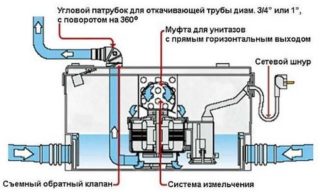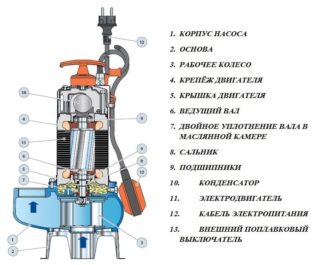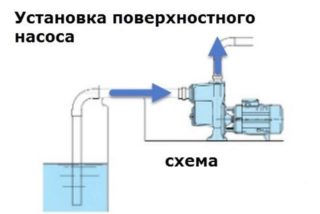For the high-quality functioning of an autonomous sewage system, a fecal pump may be needed. These devices are different in purpose, installation method. Basically, drainage units are used for storm and domestic wastewater. To choose equipment, you need to decide what it will be used for and what functions it should have.
Definition and purpose of a sewage pump

Sewage pumps pump out dirty water, which can contain large particles of debris, leaves, food waste. Owners of private houses with autonomous sewage systems most often consider such equipment as a way to clean a cesspool. However, the units are quite versatile and can be used not only for sewerage.
The device is capable of pumping very dense viscous liquids, but if the particle diameter exceeds 35 mm, the pump must be selected with the function of grinding waste, otherwise it will quickly fail due to jamming of the mechanism.
The sewage pump can be used to clean sedimentation tanks on livestock farms. In this case, it is necessary to choose a more powerful device that will work for many hours every day.
If there is a pond or lake near the house, the pump can clean sediment from the sludge. Industrial models are able to pump the peat layer, crushing it into small fractions. Liquid fuel oil or oil is also within the power of the drain pump.
In addition, the equipment pumps clean water well, giving a head up to 20 m and a capacity of up to 400 cubic meters of liquid.
In households, fecal pumps are used in a pressure sewer. If it is not possible to equip a gravity system on the site, you have to install equipment that moves the drains into the cesspool so that they do not accumulate in the pipes. A pump is necessary if the septic tank is located higher than the drain points in the house.
Depending on the device, the unit can be used to drain the pool, pump out liquid from the basement or low-lying areas of the garden, where water accumulates in spring.
Principle of operation and device

According to the method of operation, the equipment is divided into submersible, semi-submersible and surface models. Below there is a mechanism that creates a suction effect - an impeller. The liquid enters and passes through the body of the product upward, then into the pipe and out.
Submersible sewage pumps operate in a liquid medium. The liquid level indicator is a float mechanism that turns off the device and protects it from dry running. In this case, the body is completely in water and is cooled due to it. Made from durable corrosion resistant materials. The electrical cable is in a protective sheath to prevent short circuits.
Semi-submersible faecal mechanisms are the most popular models. They are resistant to full immersion, as they have a sealed housing, they cope with most of the problems that may arise in a private house. Sewer semi-submersible mechanisms are additionally equipped with shredders, which simplify the transportation of solid waste through the body.
Surface sewage pumps are not designed for liquid service. The liquid is sucked in by means of a pipe or sleeve.In this case, it is preferable to install the pipe, since the soft sleeve is capable of sticking together due to the draft, which can render the equipment unusable. Surface mechanisms make more noise, so they are not placed indoors. The cutting mechanism on submersible models is also available, it is located in front of the entrance to the body.
Types of pumps for sewerage of a private house
- After the water enters the tank, the cutting mechanism is activated.
- Solid waste is crushed.
- The pump turns on and pumps the liquid into the sump.
The metal body is housed in a plastic container to make the design look aesthetically pleasing. Materials are designed for different temperatures, the motor is selected in terms of power and pressure, depending on the length of the line inside the house.
To clean the sump, a conventional submersible pump with a cutting mechanism is suitable, since it works mainly at the bottom, where most of the solids are collected.
Criterias of choice
When buying equipment, you need to pay attention to the following parameters:
- The voltage in the network should be 220 V. With a three-phase network - 380 V. In extreme cases, it is necessary to install a voltage stabilizer, since not all equipment can withstand surges and may break.
- The height of the water column to overcome the vertical and horizontal sections of the line.
- For submersible equipment, the distance from the body to the water surface is important. For semi-submersible or surface - the maximum depth of the sleeve.
- Pump performance is the amount of liquid that it is capable of pumping per unit of time. Equipment with a capacity of up to 400 W pumps about 100 liters of water per minute, a 1 kW pump - 200 - 300 liters.
- Estimated size of large particles.
- The presence of several levels of protection against dry running - most often a float mechanism is used. The check valve prevents the liquid from draining into the sewer when the engine is turned off. The degree of protection of the case against moisture penetration must be at least 68 units according to the IP system.
- The degree of aggressiveness of the pumped liquid is taken into account. Acid-based detergents that can damage low-quality materials, as well as hot water, enter the sewer.
Ease of installation and portability is also taken into account - handles, attachments for sleeves or nozzles. Preference should be given to well-proven companies that have been operating on the Russian market for a long time, because they serve for a long time and require less costs during operation.
Carrying out the necessary calculations
This is a simplified counting scheme. When designing the system, the following are also taken into account:
- the temperature of the water entering the pipe;
- the material of the sewer system, that is, the degree of its roughness;
- the presence of shut-off valves and pressure loss during the passage of wastewater through it;
- pipe diameter;
- the speed of movement of drains and the location of the system itself - horizontal, gravity or with an upward rise.
With a complex sewer system, calculations must be trusted by professionals, otherwise design errors will affect the operation of all equipment in the future.
Installation steps
The submersible pump may have feet that are attached to a concrete base. Such models are usually installed before using the sewer system. If the need for installation arose during the operation of the septic tank, the unit is made heavier and lowered to the bottom of the pit. The ropes must be strong, it is better to use a nylon or stainless steel chain.
For kitchen or toilet pumps, it is important that the size of the inlet and outlet pipes is the same. It is not difficult to install these units according to the instructions.
Operation and maintenance
If the device is chosen correctly, it will operate without problems for about 7-8 years. The only thing that should not be allowed is the ingress of large particles into the cutting mechanism - towels, feminine hygiene products, clothing. This can cause the knives to jam.
A submersible fecal pump is able to grind tissue, rubber when pumping liquid from a pit, but if a stone or metal objects get under the knife, this can cause the pump to break down.
Equipment repair may be required in the following cases:
- the quality of the pumped liquid does not correspond to the parameters of the equipment;
- improper installation or operation;
- non-compliance with the rules for the protection of pumping equipment;
- lack of electrical protection with frequent voltage drops;
- overheating of the motor;
- depressurization of the case and water ingress into the motor;
- mechanical damage;
- wear of rubbing parts.
In the presence of a warranty card, all breakdowns are eliminated in service centers, subject to correct installation and operation.
Prices for pumps for sewerage in a private house depend on performance, power, pressure. Domestic units, if they are made with high quality, are not much cheaper than imported samples, since expensive materials and components are used in production. It is not recommended to save on equipment that is planned to operate for a long time, otherwise the repair will cost more than the device itself.











